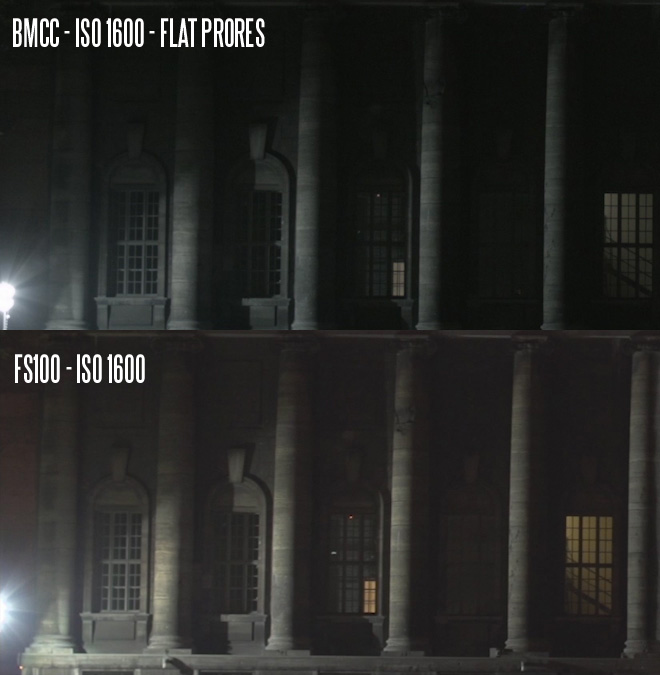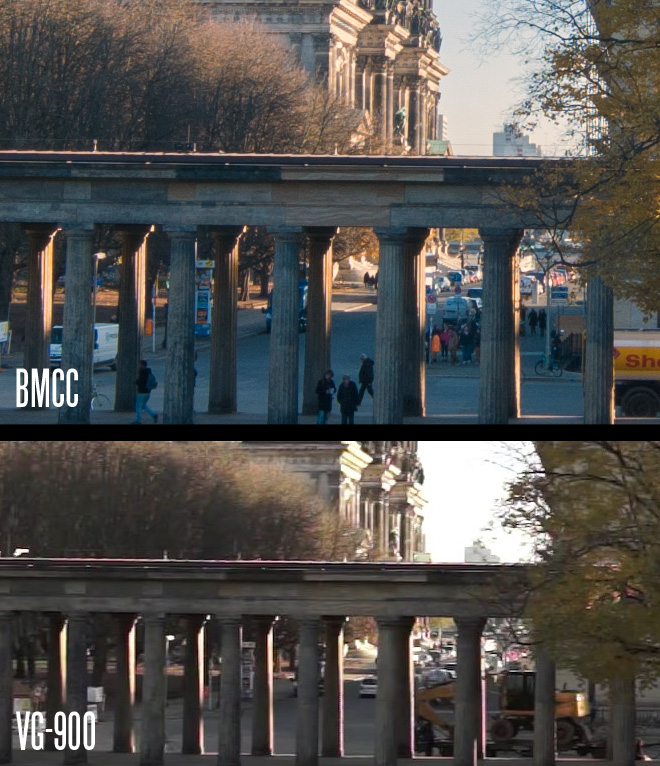In a joint shootout with Slashcam in Berlin, EOSHD put the Blackmagic Cinema Camera into a bear pit against all rivalling cameras between $500 and $4000.
It was a clear day and the results are just as stark. Download the full 2.5K shootout video. Here’s my verdict on which camera you should buy – based purely on image quality.
The following cameras are in this test:
- Blackmagic Cinema Camera (retail)
- Panasonic GH3 (pre-production v0.5)
- Panasonic GH2 (hacked)
- Sony FS100
- Canon 5D Mark III
- Sony NEX VG-900 (full frame E-mount camcorder)
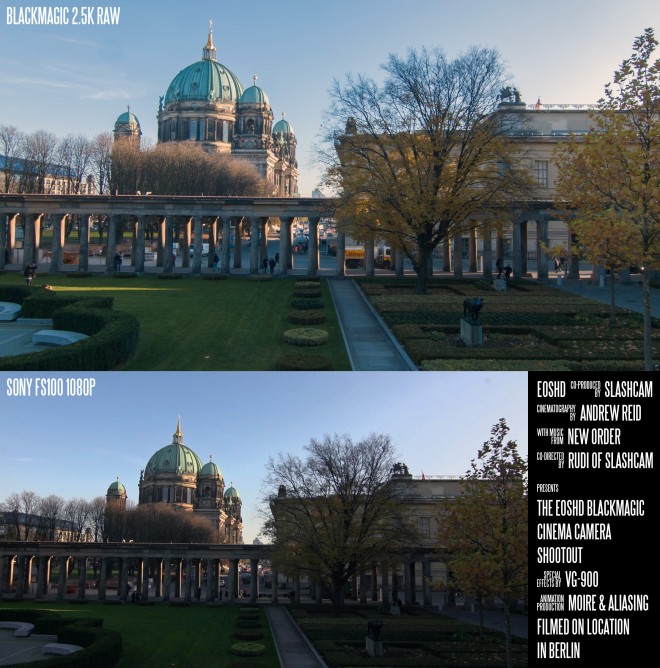
Want an eye-opener?
Click here to download the 2.5K poster frame above
New order
The Blackmagic is in a different league.
Until now I was very satisfied with my FS100 and the DSLRs but going back to them after the Blackmagic Cinema Camera is very difficult. They look way too digital. 12bit raw is like looking out of a window. Truly film-like. The colours all look odd on the DSLRs now – compressed 8bit just doesn’t cut it any more.
This is the first time DSLRS (and the FS100) are completely outclassed on image quality by a $3000 camera.
It really does make you wonder what the Japanese manufacturers have been doing these past 5 years since the Red One. The quicker they get this sorted out the better. We need raw codecs and to move on from old 1080p, at the $3000 point. Otherwise there’s no reason to get one of their products over the Blackmagic on the basis of image quality.
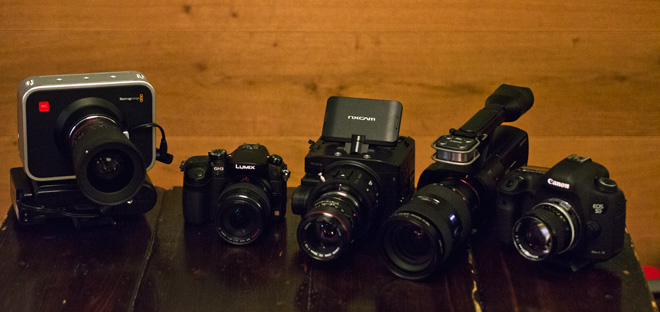
If the Blackmagic Cinema Camera ever ships in quantity this will be a serious problem for Canon, Sony, et al.
Compressed digital video is not like a JPEG where a DSLR can take its time and pack as much data as possible into the file. The compromises DSLRs make to do 1080p at 24fps are huge. The BMCC is almost as uncompromising as it gets in raw mode.
Low light
One of the biggest surprises of the test is just how good the Blackmagic camera is in low light.
I was expecting this to be a real achillies heel but it isn’t the case. With the appropriate exposure and aperture it renders crisp noise free blacks and dives deep into the shadows, with no compression, banding or sudden crushing to black. Even when boosted to the equivilent of ISO 1600 on the other cameras, it is extremely clean and maintains full resolution with noise grain which looks like a film-scan – you can hardly believe it is a digital image.
It is as clean as the FS100 is at ISO 1600.
The slight exposure and colour difference is due to the image profile used on the FS100 and the ungraded flat ProRes of the Blackmagic, but notice how the noise levels and amount of detail in the shadows between the columns are the same.
You can push it in Resolve further than an ISO 1600 exposure but after that it goes down hill very quickly. This is where the 5D Mark III and FS100 still have a special purpose on a shoot. If you need ISO 12,800 because your scene is under exposed at F1.2 with a 360 degrees shutter (1/24) then you have no option but to switch from the Blackmagic to the B-camera.
The sensor has some fixed pattern channel readout noise right at the bottom of the black levels, and if you bring the blacks up too far, this becomes visible. There’s a point where the sensor just isn’t getting any light at its native sensitivity and so areas of the image that are too dark for the 13 stops of dynamic range on offer here at ISO 800 will not be picked up – even on a raw camera the blacks do crush eventually! There’s no ISO 12,800 on this camera but what it does do is VERY GOOD ISO 1600 which is a measure of how deep the black levels are on this camera at the native ISO 800.
With a raw codec, the sensor is always at ISO 800 and you boost the exposure in post. The ISO option in the camera menu just applies a push or pull to the image for monitoring purposes. It does not change what is recorded to the SSD (unless you’re shooting ProRes of course). With a raw codec it helps to think about the image in multiple ISOs. Dark areas are ISO 1600 for example and brighter areas are ISO 200. The raw codec has the advantage that even if an exposure is lifted to ISO 1600, brighter areas of the image such as lens flare, practical light sources, candles, etc. are as clean as ISO 200 on a DSLR. This is why a candle is not a good test of low light – a candle flame is bright, and the background is usually black with no detail.
If you look at the dimly lit car door of the Mini in the shootout, that is where to spot the noise. You might need to squint a bit!
DSLRs tend to crush blacks in video mode. The black levels at ISO 800 on the Blackmagic however when shooting flat in ProRes are way higher than ISO 800 on a DSLR. More like what you’d get on the GH2 at ISO 3200.
The Blackmagic Cinema Camera out performs the GH3 and GH2 in low light. With the raw codec, shadow detail is treated equally to the rest of the image. With a compressed codec, shadow detail is the first to get hit by macro blocking and compression. The noise grain is beautiful on the Blackmagic in low light, as is the rendering of street lights, car head lamps and lens flare.
Day light
The amount of detail the Blackmagic resolves really does put the others to shame. Dynamic range is also a lot better as you’d expect from a raw codec, but not only is it wider but the quality of data is better throughout the range. Low down you have shadows which maintain colour saturation and tons of detail when you lift them in post. High up you have a lovely smooth roll off to the highlights and lots more detail. The sky is actually blue and not washed out looking.
Really you just have to look at the shootout video to see the difference, it is obvious.
Moire wasn’t an issue on this shootout. Barely noticeable even on the moire stress test shot. I did have one occurrence of the ‘black spot’ issue on the sun. This is where extremely hot highlights burn to black. Firmware 1.1 was supposed to fix this but apparently still some work to do here.
Panasonic GH3 versus GH2
The Panasonic GH2 and GH3 remain superb value, the most affordable in the shootout by far. The GH2 is $600 used and the GH3 is $1299.
The GH3’s image sharpens very well in post. With sharpness at the lowest -5 setting in-camera the GH3 looks softer off the card than the GH2 with sharpness -2 (the lowest setting on that camera). I used the sharpening filter on some shots in the shootout and these are labeled, the others are untouched.
Resolution is similar to the GH2 as long as digital sharpening, whether in-camera or in post is at an equal level on both cameras.
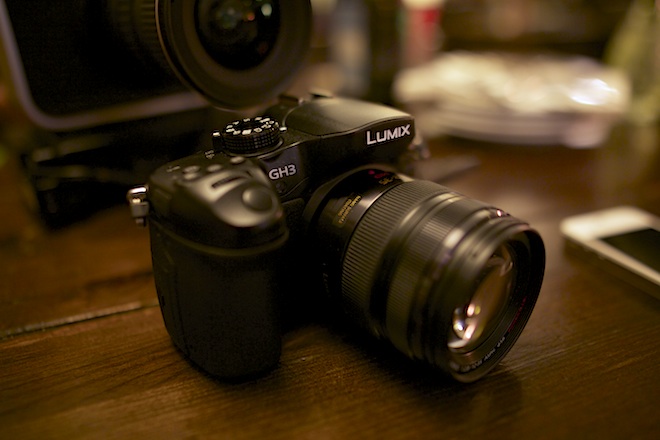
Moire was not a huge issue but the character of fine detail is different. It sometimes flutters a bit on the GH3, but you have to be pixel peeping to see it. Projected or on a TV you don’t notice it. The GH2 does have a bit of occasional moire or aliasing but it is not common. With a softer lens like the Voigtlander Nokton 25mm F0.95 wide open you get hardly any issues and the same goes for the GH3. Lumix glass is sharp but also a bit clinical for cinema in my opinion.
The GH3’s new codec does far better in the shadows than the hacked GH2 at high ISOs. It is cleaner. At low ISOs there’s less mosquito noise in the shadows too. This better codec is not just to the advantage of high ISO shots – see the shaded stone area to the right in the first shot of the shootout (all day light shots were ISO 200).
The GH3 still has a desaturated red channel compared to the 5D Mark III. This may be due to white balance rather than image processing. The glow of the orange street lighting and the golden hour sun reflecting on the autumnal tree was captured as per the eye on the 5D Mark III (well as good as you can get with 8bit) but on the GH3 and especially the GH2, I needed to boost the red channel in DaVinci Resolve to reduce the greenish / yellow hue.
Canon 5D Mark III
The more I persevere with this camera the more I like what I get. The image is horrendously soft off the card on wide angle shots but the sharpening in post brings it much closer to the GH2 in terms of resolution. On some shots you can almost match it, on others it still falls a bit short or looks a bit digital.
It also has the best colour and smoothest gradation of all the cameras bar the Blackmagic. Though it is still a long way behind 12bit raw. It certainly handles highlights better than the FS100 but shadows are much noisier, a lot of junk in the lows on this camera in comparison to the FS100 and Blackmagic.
The 5D Mark III compliments the Blackmagic Cinema Camera well for when you need that large sensor look, very high ISOs and of course stills. Dynamic range in video mode is also pretty decent for a DSLR.
Bear in mind that the DSLRs and the FS100 especially still have much to offer over the Blackmagic even though the image is now soundly beaten overall. Features like extreme low light performance up to ISO 12,800, 16MP stills, 60fps and full frame sensor are attributes not shared by the Blackmagic. In particular,the new Sony NEX VG-900 possesses all of these features and a mirrorless E-mount.
NEX VG-900
The NEX VG-900 is such a disappointment. By far the worst camera in the test, the video is a step back from the NEX 7 – which I find frankly bizarre.
Resolution on wide angle shots is very poorly rendered and extremely unstable. Resolving power is more like standard definition VHS than full HD. Aliasing and moire is produced not just by fine textures but by pretty much any vertical or horizontal line. Any fine lines shimmer and bounce. Colour is atrocious with a real lack of customisable image profiles compared to the A99 and NEX 7, yet the VG-900 is Sony’s most expensive full frame camera to date. Despite the full frame sensor, the camera delivers what seems like the dynamic range of Mini DV.
This is a $3000 (€3000 in Europe!) flagship camcorder. Some of Sony’s $500 camcorders have more resolution and less aliasing. In light of this, it appears the full frame sensor seems rather to be a marketing lead decision not an engineering one. A sensor designed for stills and not optimised for video, but shoehorned into a camcorder to grab some attention. Frankly this attitude disgusts me and it damages the Sony brand for me. Sony is about technology and performance, not the kind of chronic faults in the image that the VG-900 displays here.
Above: Sony’s idea of video image quality at $3000 is very different to Blackmagic’s
I understand they need to keep this camera under the Sony FS100 in terms of performance. But they could have done so by not bothering to make the camera. Why does it exist? Really?
The reason people like full frame sensors is for the image quality not the spec sheet. I really do feel it is full frame for the sake of it here with no real advantages for video especially when the image from the 5D Mark III, Nikon D800 and much cheaper D600 is so much better. What is bizarre is that the Nikons have Sony sensors and yet do better video than Sony’s own cameras.
Sony’s recent cameras such as the NEX 5N, NEX 7 and RX100 (all of which I bought and liked) showed big improvements in video from Sony – full manual control, 24p (25p on the PAL models), even 1080/60p with the new AVCHD 2.0 codec. I was all set for a nice step up when Sony announced the more expensive full frame models this year. This hasn’t happened with the Sony A99 or NEX VG-900.
Also on the NEX 5N and 7 I could achieve a relatively flat image profile for grading work. There’s around 10 or 12 image profiles on the NEX 7 and all customisable. Although this isn’t the same as a raw codec obviously (you are compressing the already limited 8 bit luma into a smaller range, reducing tonality and colour data still further) such a flat profile with the contrast dialled down was still useful to have. The VG-900 however does not offer the same customisability. It has hardly any image profiles and the flattest one which delivers the most dynamic range, does so by completely ruining the image with brown shadows and tons of noise. This lamentable ‘Retro’ mode gives hideous results and must be avoided at all costs. It cannot be considered a serious feature. So why is it in the camera at all?
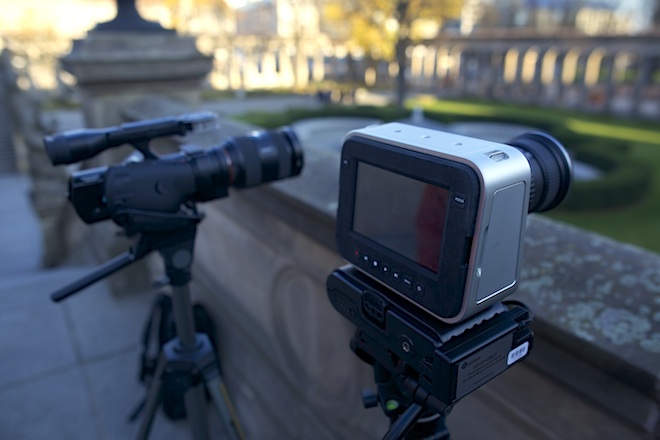
Above: the VG-900 (background) and Blackmagic Cinema Camera (foreground)
There’s bad news on the lens front too. The Metabones EOS lens to E-mount adapter caused vignetting on the full frame sensor, so marginal is this sensor to the edges of the E-mount. The Samyang 24mm F1.4 EF was unusable on this camera. This will make Canon users think twice about moving systems. A crop to APS-C can be enabled, but then the camera essentially becomes an even more expensive version of the VG-30 with nothing extra for the money and the same poor image quality. The 5D Mark III is by far the better option at the $3000 mark.
The usability of this camera is also a mess. The important controls such as iris and shutter all share the same tiny little jog dial, which is in an awkward position under the articulated arm of the screen. This jog wheel feels very cheap – like the wheel of a Matchbox car. The other most important control – no less than the record button itself – is also in a really poor position, neither directly under your thumb or finger when holding the camera normally or operating on a tripod. The button isn’t even anywhere close to the other important controls such as iris and shutter so you always need two hands on the camera. All the buttons are tiny and you’re constantly looking at where they are as you cannot really feel where your fingers are in relation to any of them.
The menus are long touch-screen scrolling lists divided into 6 areas. The touch menu options are too small for your fingers, in particular the arrow to back out of a menu. This is truly, in every way, a ‘stylus camera’. The kind Steve Jobs would have cancelled! On the NEX cameras the same menus are liveable with because you have a large scroll wheel and physical d-pad to navigate with. None of that here for your $3000.
Sony FS100
I’ve been shooting for weeks my labour of love on this camera, a Berlin based narrative music video called Dreamleaver shot mostly in low light with LOMO OCT 19 anamorphic lenses. The Super 35mm sensor is a good match to these as is the E-mount which allows OCT 19 lenses and PL lenses to be used affordably.
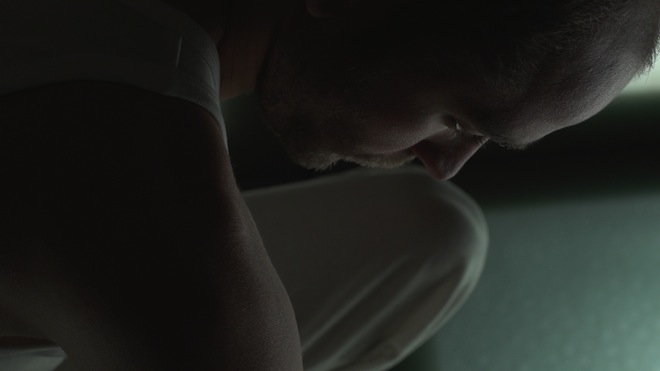
Image quality is very good and the codec holds up well 99% of the time – aside from occasionally in 1080/60p where you get some heavy compression and even some break-up of the image, depending on how challenging a particular group of frames is for the codec. The camera does do 1080/60p via uncompressed HDMI but I don’t think there’s yet any support for 60p on all external recorders but the most expensive ones.
Ergonomics – well I like how small and light the camera is, and the modular design. But the buttons are too legion and too small. Yet despite having 3000 buttons, to get more than 3 ISOs at a time you need to delve deep into some Windows ’95 style menus which Sony seem to love so much. The handling of media is occasionally annoying with messages about ‘databases’ which require attention like a crying baby. Not what you want in the middle of trying to concentrate on a shoot.
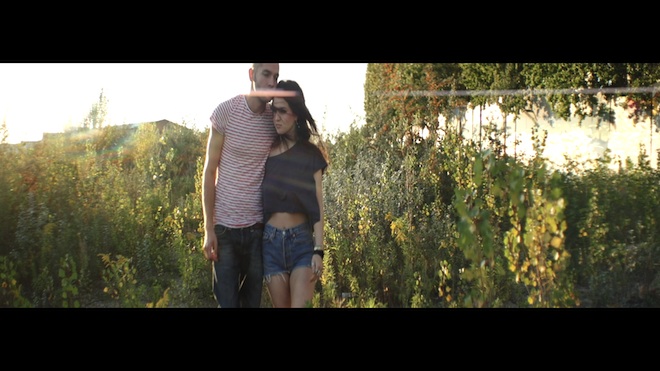
Despite some quirks though I’ve been very happy with the image.
The thing is – once you go raw you don’t go back.
In particular the highlights on this camera are poor – not a very good roll off and they even get clipped in many NLEs due to a weird bug – possibly due to the camera recording in a non-standard 15-255 instead of 0-255 and confusing the NLE into thinking it should clip the highs at 235 in keeping with the standard that DOES start at 15 (Rec.709 which is 15-235). This could also be down to which picture profile (Cinema Tone for instance) is used on the camera. But it is a headache I don’t get in raw or ProRes on the Blackmagic Cinema Camera.
What isn’t in question is that the FS100 is the absolute low light shooting king under $15,000. Only the Canon C300 is (marginally) better. Usable up to around ISO 8000, sometimes even 12,800 at a push. With the SLR Magic 50mm T0.95 this camera is INSANE!! Turns 3am into 3pm.
The main thing is that the FS100 feels like a cinema camera by a computer or electronics giant, and it is. The FS100 could do with the touch of a filmmaker in the design department. The image isn’t as cinematic as the Blackmagic Cinema Camera either and the handling is fussy. Just as well it has so many plus points like the low light performance, Super 35mm sensor size, E-mount, versatile small form factor, great battery, good internal codec, very clean shadows and uncompressed HDMI output. The screen is also great to use on a tripod below eye-level, though the positioning is less ideal for shots above eye level.
Lenses
Rudi and I matched the shots as closely as possible in terms of field of view and depth of field even though the cameras have a range of sensor sizes. The 5D Mark III and Sony NEX VG-900 have full frame photographic sensors. For wide angle here we chose 24mm. The Sony FS100 is Super 35mm (approximately APS-C) and wide angle here was 16mm. The GH2 is a 1.86x crop and the the GH3 is 2x crop – wide angle here is 12mm and I purposefully chose the same focal length on both to show how much wider the GH2’s sensor is. The Blackmagic Cinema Camera is a small further 0.3x crop over the GH3 which did not make much difference in comparison and we used the Tokina at 11mm for wide angle shots on that camera.
All the lenses used in the test were:
- Panasonic 12-35mm X (GH3 kit option)
- Olympus 12-50mm (OM-D kit option)
- Tokina 11-16mm F2.8 (Wide angle on the Blackmagic)
- Sony Alpha 24-70mm F2.8 (on the VG-900 only)
- Samyang 24mm F1.4
- Samyang 35mm F1.4
- Canon 40mm F2.8 EF
- Canon FD 50mm F1.2
- Nikon 85mm F2.0
Looking above $4000
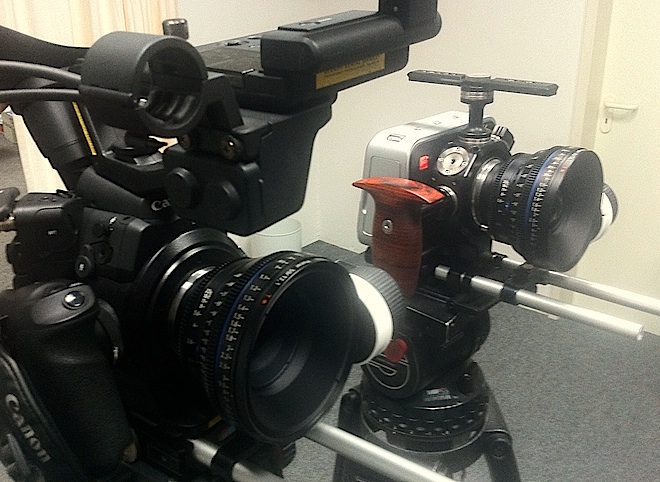
When you look above $4000 you will find the Canon C300 (above), Red Scarlet, Sony FS700, Canon 1D C, Canon 1D X, Canon C100 and ‘battle tested’ Red One.
The FS700 has roughly the same image as the FS100 but built in NDs, high frame rates and future 4K upgradability. It is however double what a used FS100 costs and the 4K upgrade will add a second $4000. It will be very interesting to see how much more cinematic the 4K output is when it is reading out all the pixels. I’m betting the image is a big step up not just in terms of resolution but for dynamic range and tonality too, but of course we’ll have to wait and see.
The 1D C has a very cinematic image and is 4K full frame. Very nice. In Canon LOG mode it is also very flat – but remember with an 8bit codec, that comes at the price of more banding and even less gradual steps between shades and colours.
At Photokina I recorded some footage at 4K and 1080p with the 1D C and noticed that in 4K the image was much flatter and had more dynamic range. Here’s a still capture and below are the 100% blow-ups. As you can see in 4K mode it does of course resolve far more than in 1080p which unsharpened is similar to the 1D X and 5D Mark III.
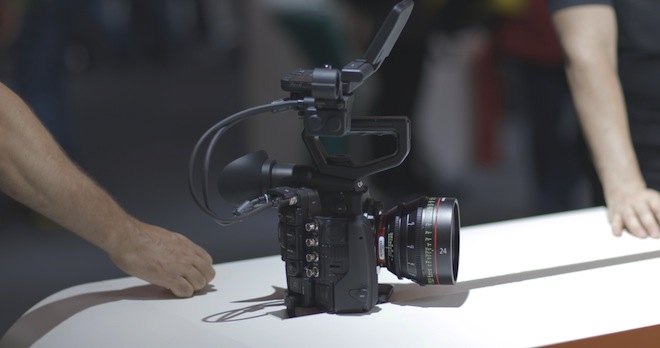
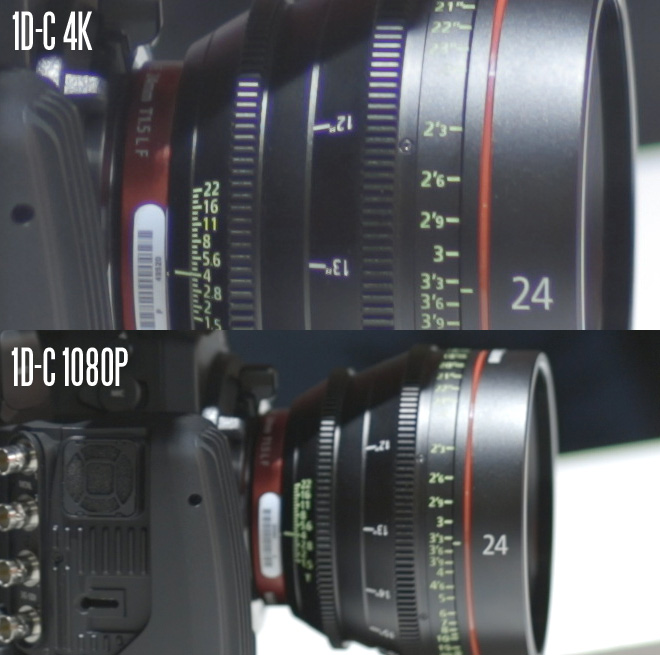
However it is still just MJPEG. That 4K image is not quite truly 4K in terms of detail and the gradation is hardly 12bit raw. According to Shane Hurlbut the pre-production Canon 1D C suffers from moire in 4K. If this was a $6000 offering I’d have no trouble recommending it but the $12,000 price tag? It isn’t raw, rolling shutter isn’t great, 4K isn’t all that sharp 4K, no 25p in 4K, no XLR or HD-SDI, ergonomics are the same as a DSLR and it records to 8bit MJPEG. Imagine what this camera could do if it was actually designed as a cinema camera not just a 1D X with a different circuit board and firmware update. A shame because it IS a very cinematic image from a superb sensor – if you can afford it. The Canon 1D X is $6000 but is it really that much better than the 5D Mark III sharpened in post? I’d say not but if you need the best pro-DSLR on the market for stills then it is worth the extra.
The C100 with an external recorder is very similar if not identical to the C300 in terms of image quality and a lot cheaper. Unfortunately they are both 8bit 1080p cameras and the Blackmagic has the better image. On the BMCC there’s more detail in the shadows with a raw codec and a more gentle roll off to the highlights – less digital looking and more like a film scan. The motion cadence is nicer, better colour gamut, lovely film-grain, more resolution in 2.5K and a better codec in 1080p (ProRes and Avid DNxHD are native editing formats as well as being super high bitrate – 200-350Mbit. The MPEG codec on the C300 is 50Mbit whilst AVCHD on the C100 tops out at just 24Mbit). The Canon C100 and C300 are both very good 1080p cameras. The problem is that the Blackmagic is a very good 2.5K raw camera!
The Red One I don’t have any real experience with so I can’t comment. But John Brawley has. He says the Blackmagic Cinema Camera has the better low light, dynamic range and colour gamut. So this choice really comes down to how badly you want 4K and a Super 35mm sensor. The Red One is also EOL and likely won’t be easy to get hold of in the future. There’s also issues around support and reliability, plus the long boot-up times and huge storage requirements for 4K raw are a hassle for certain shooters. No ProRes mode either. The Red Scarlet you’re talking $15,000 for the basic kit altogether compared to $3000-$4000 for the Blackmagic Cinema Camera. I am aiming to do a shootout in Berlin with this camera soon but certainly my expectations are that the Blackmagic Cinema Camera is as good at 2.5K raw as the Scarlet at 2.5K raw.



